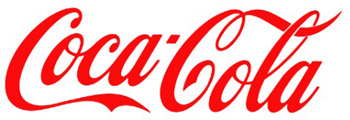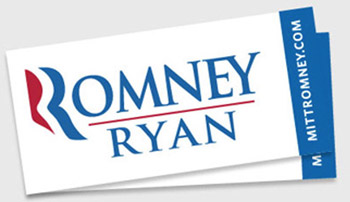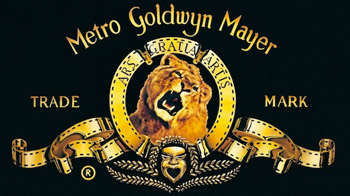Prior to the domain 5NorthMarketing.com changing ownership in 2017, a wonderfully informative marketing blog lived at this address. Below is one of the archived articles from back then. Please note that the content below is not property of the current owners of 5NorthMarketing.com but, we believe, contains wonderfully written and insightful information worth sharing.
4 Keys to Unforgettable Logos
While watching the Republican National Convention several weeks ago, I noticed the new logo for presidential hopeful, Mitt Romney, and his new running mate, Paul Ryan. My first thought when I saw the logo was, "Who is Omney?"
So I was inspired to write a post on logo design, with the help of PBS' Off Book series. (Watch full video here.)
The History of Logos
Logos trace their history all the way back to pictorials used thousands of years ago. They were used in books, street signs, and churches, mainly to communicate with the illiterate masses. They were used by merchants to show their offerings and were used as trademarks to signify the origin or quality of a craftsman's product.
Logo use increased over the years and really got its start, as we know it today, at the beginning of the 20th century with the introduction of color printing and the birth of the advertising industry. At the beginning, logos used design elements and words that were already familiar to most people so that the public could readily understand the meaning of a given symbol.
Over the last century, with the increase of commerce, and especially the growth of competition among an ever-growing number of companies, logos began to be used more and more to help distinguish between similar entities.
But while the world we live in has gradually become more complex, the design of logos has become simpler for ease and speed of recognition in a fast paced world.
Today, it is important for logo designers to understand that "less is more". Logos must be simple yet intelligent images that are skillfully designed to convey a company's personality, standard, quality, or brand, both consciously and sub-consciously, for immediate recognition by its target audience.
4 Keys to Great Logo Design
"Logo designers have to have a sense of what the company wants its personality to be. And then it manufactures this mask. And the logo is essentially a mask. It's an identifier. But it's also something which stands in for who you are." –Steven Heller
This mask is crucial because it expresses your image and personality, at a glance, to the world. You can make sure your logo accomplishes that monumental task by following these four keys.
1. Memorable
A logo, first and foremost, must be memorable.
"Often it's something awkward, or something that throws off the balance." –Sagi Haviv
The logo for Mobil Oil is a great example. What makes it off balance, that one red "o" in the middle of blue lettering, is also what makes it memorable and immediately identifiable.
2. Appropriate
A logo must appropriately and accurately communicate what the company is and does.
"It should be appropriate in the character, the feeling. If you look at the Smithsonian sun and you say, 'Is that appropriate for an institution that has all these different galleries and museums?' And then you start thinking, 'Does it look too corporate?' No, it doesn't? 'Does it look too commercial?' No, it doesn't. That is what we ask ourselves when we look at a mark, 'Is this right for them?'" –Sagi Haviv
3. Simple
"A logo can't express everything but it should definitely express the thing that is the most important, the thing that needs to be expressed." –Kelli Anderson
In the fast moving world we live in today, with images flying by us on TV, web browsers, smart phones, and buses, it is more and more difficult to remember anything. That's one reason why a logo has to be simple. Is there any logo that is simpler, yet more memorable, than the Apple logo?
A logo must also be simple because it has to "work everywhere and look the same in every situation.
"In today's media reality, if it could be as tiny as 1616 pixels to work as a favicon or on the sides of buildings, that's tremendous." – Sagi Haviv
4. Timelessness
Coca Cola is a great example of a timeless logo. Yet it uses old school script and was designed in the 1890s. So how does it always look contemporary? Because it has become an enduring part of our culture.

Often the most timeless and appropriate logo has an overwhelming feeling of obviousness. And there is nothing wrong with being obvious in your design because that usually means it is appropriate.
"It is a fashion business. There are styles that change and typography that changes and images that change. But what you want is you want your audience to see [your logo] and it will remind [them] of [your] entity. That's when a logo works. That's when it becomes timeless." –Gerard Huerta
A great logo transcends time and when your audience sees your logo and is instantly reminded of your brand, then there is little reason to ever change it.
However, we often feel the need to change our logo or our branding, mostly because we're bored, or maybe because we want to improve our logo to make it more modern and fresh. And there is often good reason for that. But how many times have the New York Yankees changed their logo? Is there room for improvement? Could it be more modern? Yes. But could it be more timeless? No. And therein lies its effectiveness. You know exactly what that logo stands for, baseball fan or not.

Conclusion
"When a design fulfills these parameters, with time it will build equity and will build recognition." –Sagi Haviv
When it comes to designing a great logo, think about who you are and how you want your customers to view you. Then based on that personality, get one idea that you believe in and iterate over and over again. Experiment with colors, transparency levels, size, and even the relationship between those different elements.
"We need the logo so that people will be cued into who we are and what we do." –Gerard Huerta
So find a way to tell your story that is memorable, appropriate, simple, and timeless.




